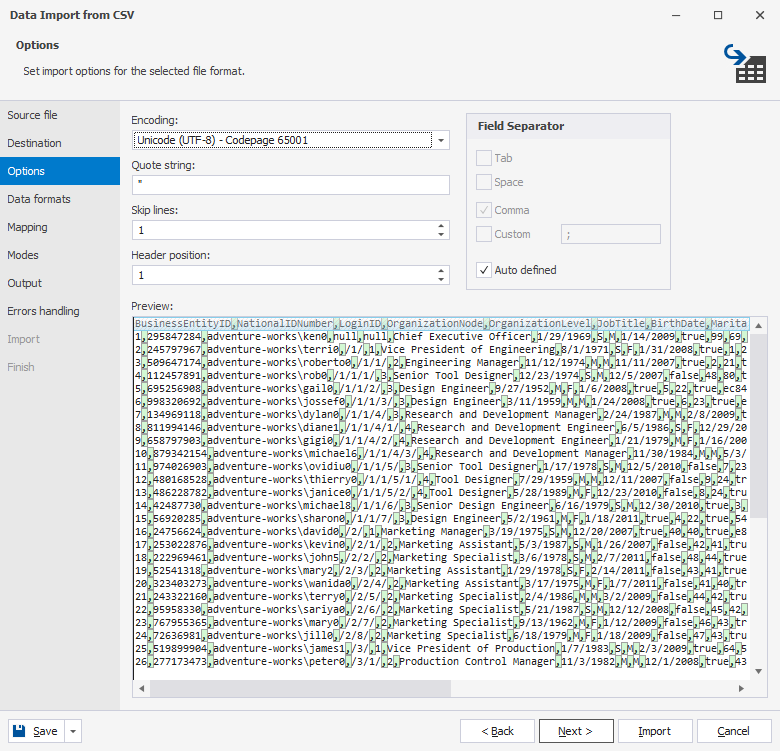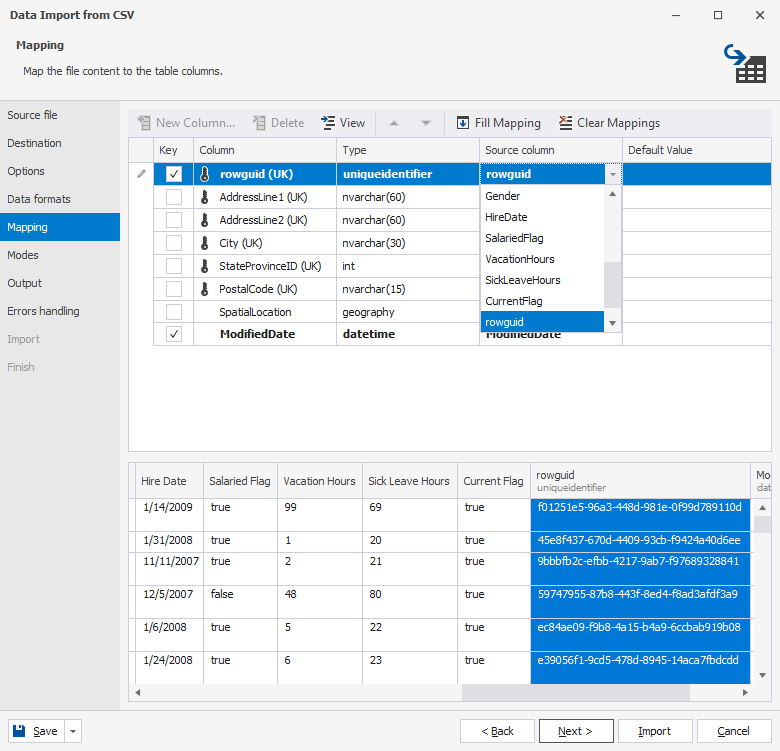CSV import
This topic describes how to import data from a CSV file.
Note
Data Import Wizard pages can slightly differ due to the product you have been using.
-
Decide what table to import the data to:
For a new table:
- On the Database menu, click mport Data. The Data Import wizard opens.
For an existing table:
-
Right-click a table in Database Explorer and select Import Data from the shortcut menu. The Data Import wizard opens with predefined parameters: a Microsoft SQL Server connection, a database, and a table to import the data to.
-
Alternatively, on the Database menu click Import Data, and select a required table on the Destination table wizard page.
-
Select CSV import format and specify a location of Source data. Click Next.
-
Specify a Microsoft SQL Server connection, a database, a schema and a table to import the data to. If you selected a table in Database Explorer before opening the Data Import wizard, the wizard will open with the predefined connection parameters of the selected table. To create or edit Microsoft SQL Server connections, click the corresponding buttons. Click Next.
- Preview the Source data and specify additional options to customize the import:
- Set a quantity of lines to skip during the import. Lines are counted from the top.
- Select the line number where the table header is located. It will be highlighted with blue in the Preview section. If you don’t specify the header position, the imported columns will get default names - column1, column2, etc.
- Specify a column delimiter. See the result in the Preview section.
-
Click Next.

- Specify data formats for the Source data and click Next.
-
Map the Source columns to the Target ones. If you are importing the data into a new table, dbForge Studio will automatically create and map all the columns. If you are importing into an existing table, only columns with the same names will be mapped, the rest should be mapped manually. (If no columns with the same name are found, they are mapped in succession - the 1st column in Source with the 1st column in Target, etc.)
See the Target columns in the top and the Source columns at the bottom of the wizard page. Click Source column fields and select required columns from the drop-down list. (For more information about mapping, go to Mapping, Data Import Wizard topic.)

Note
To cancel mapping of all the columns, click Clear Mappings on the toolbar. To restore it, click Fill Mapping.
- If you are importing to a new table, you can edit the Target column properties by double-clicking them in the top grid. Select the Key check box for a column with a primary key and click Next.
Note
You should select at least one column with a primary key, otherwise some of import modes on the Modes wizard page will be disabled.
- Select an import mode to define how dbForge Studio should import the data. Click Next.
- Select how dbForge Studio should handle errors during import and whether you want to get a log file with details about the import session.
- Click Import and see the import progress. dbForge Studio will notify you whether the import completed successfully or failed. Click the Show log file button to open the log file.
- Click Finish to finish the import and close the wizard.
Note
You can save the import settings as a template for future uses. Click Save Template on any wizard page to save the selected settings. Next time you should only select a template and specify a location of the Source data - all the settings will be already set. For more information, go to the Using Templates topic.
Download dbForge Studio for SQL Server and try it absolutely free for 30 days!